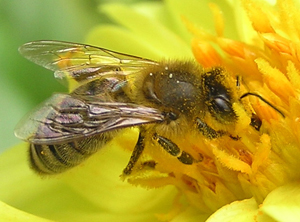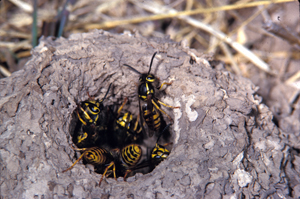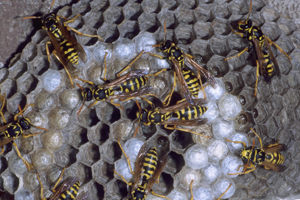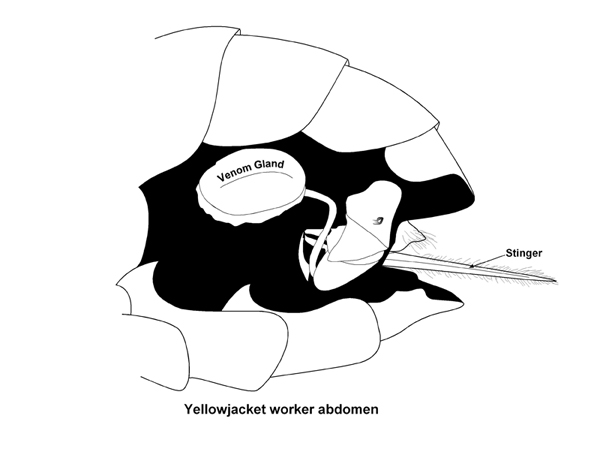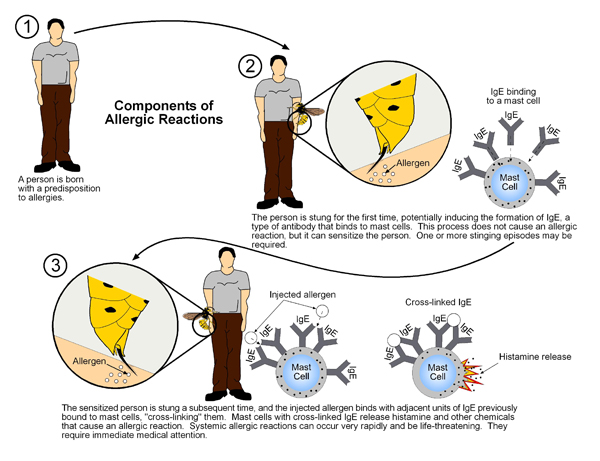
Insects and Ticks > Stinging Insects
Stinging insects and the medical risk associated with their venoms are complex topics, and presentation of information pertaining to them requires the use of technical terms. These terms are depicted in bold type and are explained in the glossary.
Stinging insects belong to the insect order Hymenoptera, the group that consists of ants, wasps, and bees. Their presence around humans can cause fear and disrupt outdoor activities, but only a very small number of species are a medical risk. The most problematic are the social species that exist in colonies, including ants, the social wasps, and the social bees.
What Is the Medical Risk of the Social Hymenoptera?
The medical risk associated with the social Hymenoptera is due to the following. All ants, social wasps, and social bees exist in colonies that consist of multiple individuals and they sting in defense if their colony is disturbed. Stings are painful because they inject venom that contains specific chemicals that cause an immediate burning sensation. The venom also contains chemicals that are involved in allergic reactions.
The possibility of a person suffering a serious reaction is very low, however. Only a small percentage of people in the U.S. are at risk of experiencing such a reaction. These individuals are prone to allergy (atopy) and are referred to as being "atopic." Atopic individuals potentially suffer one or more conditions such as hay fever, house mite allergy, penicillin allergy, allergy to foods such as peanuts and shellfish, and allergy to venoms of social Hymenoptera.
Approximately 0.5-4.0% of the U.S. population is prone to developing allergy to social Hymenoptera venoms. These individuals are at risk of experiencing allergic reactions known as "immediate hypersensitivity reactions," including life-threatening systemic anaphylaxis. An estimated 40-50 deaths per year are due to anaphylaxis, but there is general agreement that the number is greatly under-reported. The vast majority of deaths occur within minutes to a few hours of the stinging episode. The most common specific cause is respiratory failure due to constriction of airway passages and swelling in the throat area. The next most common cause is cardiovascular collapse due to a rapid drop in blood pressure.
How Many Types of Stinging Insects Are There?
Worldwide, there are an estimated 9,000 species of ants, 20,000 species of bees, and 800 species of stinging wasps. Again, those of medical risk are social, existing in colonies consisting of numerous females known as "workers" that defend by stinging. In the U.S., social Hymenoptera include all 700 or so species of ants, but only about 35 species of bees, and about 30 species of wasps.
ANTS:
Nearly all species can sting, but relatively very few are a medical risk. Ants of greatest medical risk in the U.S. are the so-called "fire ants," all of which are limited to southern, southwestern, and western states. Fire ants can be very common in certain habitats and their colonies typically consist of many thousands of workers. The workers will deliver a sting that produces an intense burning sensation if their colony is disturbed. Allergic reactions are reported in an estimated 1% of individuals who are stung.
Visitors to the southwestern U.S. should be aware that desert ants known as "harvester ants" inflict stings that are extremely painful (likened to turning a screw into the flesh) and the pain can last for several hours. There are no reports of allergic reactions to stings of these ants, however.
SOCIAL BEES:
The social bee of greatest medical risk in the U.S. is the honey bee, Apis mellifera. Honey bees exist in colonies that consist of many thousands of workers associated with a nest. The nest consists of wax formed into structures known as "honey combs" in which larvae are reared. Honey bees are a medical risk because they can be very common even in urban areas, people commonly come in contact with them, colonies can consist of many thousands of workers, workers sting if their colony is disturbed, and their venom contains several chemicals involved in allergic reactions.
NOTE: The Africanized honey bee or the so-called "killer bee" is found in parts of the southern, southwestern, and western U.S., but does not occur in Indiana. It is nearly identical to "normal" honey bees in appearance and in the composition and effects of its venom. In other words, Africanized honey bee venom is not more "toxic" or prone to cause allergic reactions. The most important aspect of medical risk is directly associated with behavior. In short, Africanized honey bees are much more prone to defend their colony and the amount and duration of stinging is much greater.
Bumble bees also are social, and about 30 species exist in the U.S. None are considered a significant medical risk. Colonies typically are built in the ground in association with abandoned rodent nests and people rarely come in contact with them. Colonies of many species of bumble bees contain fewer than a hundred workers and workers are much less prone to sting than are honey bee workers. Relatively very little has been reported on the chemistry of bumble bee venoms, but they share at least some allergens with honey bee venom and have been associated with allergic reactions.
SOCIAL WASPS:
The social wasps are of greatest medical risk (equal to honey bees and for many of the same reasons) throughout the U.S. are the yellowjackets, and to a lesser extent the hornets. Both groups exist in colonies that consist of hundreds to several thousand workers associated with a nest made of papery material. Yellowjacket and hornet larvae are reared in cells formed into multiple combs that are fully enclosed within a thick papery envelope. Paper wasps, or umbrella wasps, are significant medical risks primarily in the southern and southwestern U.S. However, the relatively recent establishment of a European species, Polistes dominulus, over much of the northern U.S. may change this situation because this species is increasingly common in urban areas and workers are more prone than native species to sting in defense if their colony is disturbed. The common names paper wasp and umbrella wasp are descriptive because the papery nest consists of a single comb that is not enclosed within an envelope and nests usually resemble an umbrella in shape when they are suspended from eaves of a building. Their colonies are much smaller that those of yellowjackets and hornets, usually containing fewer than a hundred workers.
The vast majority of species of bees and wasps are not social insects and are not a medical risk. They are considered "solitary," and include numerous very common examples such as carpenter bees, the cicada killer, mud daubers, and spider wasps. Solitary bees and solitary wasps do not exist in colonies consisting of numerous workers, almost never sting in defense of their nest, and their venoms cause nothing more than burning pain that persists for a minute or two.
What Should I Know About the Stinging Behavior of Social Hymenoptera?
Workers of social Hymenoptera are females that possess a structure known as an "ovipositor," which in most female insects is involved in laying eggs. However, the ovipositor of ants, bees, and wasps is modified to deliver a sting and is not involved in laying eggs. Known as a "sting" or "stinger," it functions as a hypodermic needle through which venom is injected into animals that disturb the colony. Male ants, wasps, and bees lack an ovipositor and thus cannot sting.
What Should I Know About the Venoms of Social Hymenoptera?
Venoms of social Hymenoptera vary in composition, but all contain a complex mixture of chemicals. They include chemical compounds such as histamine, peptides, and enzymes such as hyaluronidase and phospholipase. Several of these chemicals cause immediate burning pain and thus are involved in defending the colony against predators such as raccoons and bears, or people who disturb the colony. Unfortunately, certain of the peptides and enzymes are allergens that are associated with inducing and eliciting allergic reactions, including systemic anaphylaxis.
The venoms of solitary wasps such as the cicada killer, mud daubers, and spider wasps consist primarily of chemicals that function in subduing and paralyzing other insects and spiders used as food for their larvae. These chemicals produce their effect on the nervous system of the prey and have little effect on humans aside from causing minor, temporary pain. However, venoms of some species of spider wasps contain chemicals that cause extreme but temporary burning pain. The venoms of solitary wasps are not known to contain allergens, and there are no reports of allergic reactions in people stung by them. The same is true of solitary bees such as carpenter bees.
What Stages Are Involved in Allergic Reactions?
Allergic reactions involve a sequence of complex "steps." The explanation begins with a person who is prone to allergy being stung by a species of social Hymenoptera for the first time. This initial exposure to the venom does not induce an allergic reaction. One or more stinging episodes is needed to induce the primary immune response, which is described below.
An allergen or allergens in the injected venom induces certain cells of the immune system to form specific antibody (IgE) that attaches to mast cells found in connective tissue of the skin, lung, gut, and in tissue surrounding blood vessels. Some estimates claim there are as many as 50,000 IgE receptor binding sites per mast cell, and the amount of specific IgE is very high in an allergic person. Once the specific IgE antibody has attached to mast cells, the person is sensitized to the allergen or allergens in the injected venom.
A sensitized person who experiences a subsequent sting (perhaps months to years later) by the same or closely related species of social Hymenoptera may suffer an allergic reaction. This results when the newly injected allergen or allergens bind to receptors on specific IgE antibody molecules that had attached to mast cells during a previous stinging episode. The process results in the release of the chemical mediators of an allergic reaction. These chemicals include large quantities of histamine, an important contributor to allergic reactions. Histamine can cause smooth muscle contraction, leakage of fluid from blood vessels, and extensive swelling in airway passages and the throat. These effects are significant components of allergic reactions, including life-threatening systemic anaphylaxis.
What Symptoms Are Associated with Systemic Anaphylaxis?
Systemic anaphylaxis is a serious, potentially life-threatening allergic reaction. Symptoms typically begin within minutes of a sting, but can be delayed for an hour or so. The symptoms are systemic, that is, they involve the body, not just the area in which the venom was injected. For example, a sensitized person stung on the finger may experience difficulty in breathing due to extensive swelling in airway passages and the throat. Another symptom of anaphylaxis is rapid drop in blood pressure (shock) resulting from leakage of fluids from blood vessels. These symptoms are associated with excessive quantities of histamine and other chemical mediators that have been released from mast cells.
NOTE: Most allergic reactions that are systemic do not result in anaphylaxis. However, they can include a variety of symptoms of varying seriousness such as: weak and rapid pulse; dizziness and fainting; nausea, diarrhea, and vomiting; anxiety and confusion; and itching and development of hives on areas of the body apart from the site of the sting. While in themselves not life-threatening, these symptoms are evidence that a person is sensitized and should consult with a physician as soon as possible.
What Should I Know About Emergency Treatment for an Allergic Reaction?
A person experiencing an allergic reaction following a sting should seek medical attention immediately! Systemic anaphylaxis can proceed very rapidly and requires rapid emergency medical intervention. The reader should be aware that antihistamines may reduce local swelling, but they do not reverse or even block the life-threatening symptoms of respiratory failure and cardiovascular collapse.
There is, however, a specific medication that has the potential to block a systemic reaction. It is known as "epinephrine" and is administered by injection (see below). Epinephrine acts by increasing smooth muscle contraction, increasing cardiac output to counter shock, and inhibiting further release of histamine from mast cells. Effectiveness is greatest if administered immediately after a sting before symptoms begin.
What Should I Do if I Suspect that I am Sensitized?
You should consult as soon as possible with a physician who specializes in allergies if you experience any of the symptoms of a systemic reaction (mentioned above) following a sting. An allergist can conduct tests to determine if you are sensitized to a venom or venoms of social Hymenoptera. The test most likely will involve venom of the honey bee, yellowjackets, hornets, and paper wasps, and fire ants if the person lives in the southern and western U.S. People who have a confirmed sensitivity typically are prescribed a "medic alert bracelet" that indicates the condition. They also may be prescribed a "sting emergency kit" that contains a syringe with a pre-loaded dose of epinephrine.
Some individuals who are sensitized may be candidates for venom "desensitization". This is a process that involves a series of injections of minute, but increasing quantities of pure venom containing the allergen or allergens to which the person has been sensitized. Venom desensitization can be highly effective, but it is not appropriate for every person. Consultation with an allergist will determine this.
If I Am Sensitized to One Type of Venom Can I Have an Allergic Reaction to Another Type?
Venoms of certain closely related species of social Hymenoptera can contain the same allergen or very similar allergens, and thus it is possible for a person to be allergic to the venom of more than one species. For example, a person who is allergic to yellowjacket venom might also be allergic to hornet venom or paper wasp venom, but only if the person is sensitized to the same specific allergen present in all the venoms. In contrast, the venoms of social wasps and the venom of the honey bee differ substantially in chemical composition, including most of the potential allergens. Thus a person allergic to honey bee venom usually is not allergic to venoms of social wasps, and vice versa. Again, however, allergy to social Hymenoptera venoms is a complex topic and people concerned about it should consult with an allergist.
Where Can I Find More Information About Allergy and Allergic Reactions?
The following website contains accurate and current information on allergy and allergic reactions, including anaphylaxis.
A recent (2002) textbook by G. Mullen and L. Durden, Medical and Veterinary Entomology, has an excellent chapter devoted to stinging Hymenoptera that covers biology, behavior, and medical risk. Another recent (2006) textbook by Abbas, A.K. and A.H. Lichtman, Basic Immunology Functions and Disorders of the Immune System, has an excellent chapter devoted to allergic reactions, including anaphylaxis.
We greatly appreciate the assistance of Dr. Steven Wikel, University of Connecticut Health Center, in developing the information pertaining to allergy and allergic reactions.
